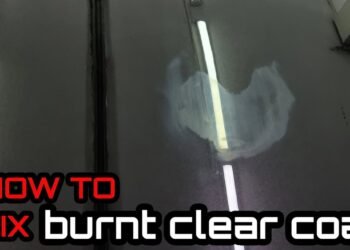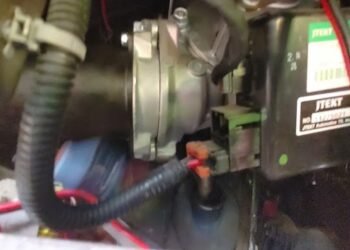If you own a Porsche Cayenne, spotting a coolant leak can be worrying—and for good reason. Coolant leaks don’t just mean a puddle under your car; they can lead to serious engine damage if left unchecked.
You might notice warning lights on your dashboard or an unexpected rise in engine temperature. But why is your Cayenne leaking coolant, and what can you do about it? Understanding the common causes and knowing the signs will help you act quickly and avoid costly repairs.
Keep reading to learn everything you need to know about Porsche Cayenne coolant leaks, how to identify them, and the best solutions to keep your luxury SUV running smoothly.

Credit: www.youtube.com
Common Leak Sources
Coolant leaks in a Porsche Cayenne can arise from several common parts. Identifying the exact source helps prevent engine overheating and costly repairs. These leaks often occur due to wear, damage, or age-related issues in the cooling system components.
Understanding the typical leak sources can guide timely inspections and fixes. Each part plays a vital role in maintaining the coolant flow and engine temperature.
Worn Hoses And Seals
Hoses and seals carry coolant throughout the engine. Over time, heat and pressure cause them to crack or harden. These worn parts develop holes or loose connections. Leaks often appear where hoses join other components. Regular checks can spot leaks early and avoid major damage.
Faulty Water Pump
The water pump moves coolant through the engine. A failing pump may leak coolant from its seals or housing. This leak usually appears near the front of the engine. A broken water pump can cause overheating and engine failure. Replacing the pump stops the leak and restores cooling.
Damaged Radiator
The radiator cools the hot coolant before it returns to the engine. Cracks or corrosion create small holes that leak fluid. Road debris or impacts can damage the radiator fins and core. A leaking radiator lowers coolant levels quickly. Repairing or replacing the radiator fixes the leak.
Cracked Coolant Reservoir
The coolant reservoir stores extra fluid and allows expansion. Plastic tanks can crack from heat or physical stress. Cracks cause visible leaks and coolant loss. A cracked reservoir must be replaced to maintain proper coolant levels. This repair prevents engine overheating and coolant shortages.
.jpg.82cb3003a2dcdf94c5d3c2a30489cbb0.jpg)
Credit: www.renntech.org
Signs Of Coolant Leaks
Detecting a coolant leak in a Porsche Cayenne early can save costly repairs. The signs often appear before major damage occurs. Knowing these indicators helps maintain your vehicle’s health and performance. Here are the most common signs to watch for.
Visible Puddles
Coolant leaks often leave bright-colored puddles under the car. Pink, green, or orange fluid can collect on your driveway or garage floor. These puddles usually appear after the car has been parked for a while. Spotting them early is crucial to prevent engine damage.
Overheating Engine
An overheating engine may signal a coolant leak. Without enough coolant, the engine temperature rises quickly. You might notice the temperature gauge moving into the red zone. Overheating can cause serious engine problems if not addressed.
Low Coolant Levels
Check the coolant reservoir regularly. If you see the level dropping often, a leak might be present. Low coolant levels reduce the cooling system’s efficiency. This causes the engine to run hotter than normal.
Sweet Smell Or Steam
A sweet smell near the engine or inside the car suggests a coolant leak. Coolant has a distinct sweet odor. Steam coming from under the hood also indicates fluid escaping from the cooling system. Both signs require immediate attention.
Diagnostic Steps
Diagnosing a coolant leak in a Porsche Cayenne requires careful steps. Each step helps identify the exact source of the leak. Proper diagnosis avoids unnecessary repairs and saves money. Below are key diagnostic steps to follow.
Visual Inspection
Start with a clear visual check of the engine bay. Look for wet spots, stains, or puddles of coolant. Inspect the radiator, reservoir, and water pump areas. Check the ground under the vehicle for signs of leaking coolant. Notice any cracks or worn parts that may cause leaks.
Pressure Testing
Pressure testing helps find leaks not visible to the eye. Use a cooling system pressure tester and pump it to the recommended level. Watch for drops in pressure, which indicate a leak. This test forces coolant to escape from weak points. It pinpoints leaks in hoses, radiator, or engine seals.
Coolant Dye Test
Add a special UV dye to the coolant system. Run the engine to circulate the dye through all parts. Use a UV light to scan the engine and hoses. The dye will glow where coolant is leaking out. This test reveals small or hidden leaks that are hard to spot otherwise.
Checking Hoses And Connections
Inspect all coolant hoses for cracks, brittleness, or swelling. Check hose clamps and connections for tightness and corrosion. Loose or damaged hoses often cause leaks. Replace any suspect hoses and secure clamps firmly. This step prevents future leaks from weak hose parts.
Repair Options
Coolant leaks in a Porsche Cayenne require prompt repair to avoid engine damage. Several repair options exist depending on the leak’s source. Choosing the right fix ensures the vehicle runs smoothly and stays cool under pressure.
Hose Replacement
Coolant hoses often wear out due to heat and pressure. Cracks or holes cause leaks that reduce cooling efficiency. Replacing damaged hoses stops leaks and restores proper coolant flow. This repair is usually quick and affordable.
Radiator Repair Or Swap
The radiator cools the engine by circulating coolant. A damaged radiator can leak or block coolant flow. Repairing minor radiator cracks may work temporarily. Severe damage needs a full radiator replacement to prevent overheating.
Water Pump Fix
The water pump moves coolant through the engine and radiator. A faulty pump can cause leaks and overheating. Repair involves replacing seals or the entire pump. Fixing the water pump is crucial for engine health.
Coolant Reservoir Repair
The coolant reservoir holds extra fluid for the cooling system. Cracks or leaks in the reservoir can lower coolant levels. Repair or replacement of the reservoir stops leaks and maintains proper coolant balance. This keeps the engine running cool and safe.
Cost Factors
Understanding the cost factors for fixing a Porsche Cayenne coolant leak helps prepare for repair expenses. Several elements influence the final price. These include parts, labor, and the severity of the leak. Also, the specific model of the vehicle and any additional services needed affect costs. Breaking down these factors makes the repair process clearer and budget-friendly.
Parts And Labor
Parts for the Porsche Cayenne vary in price. Genuine components often cost more but ensure quality. Labor charges depend on the repair shop’s rates. Complex repairs require more hours, increasing labor costs. Simple fixes like hose replacements take less time and cost less.
Severity Of Leak
Small leaks might only need a quick patch or hose swap. Larger leaks could involve replacing the radiator or water pump. Severe damage may require extensive work, raising the repair bill. Early detection saves money and prevents further damage.
Vehicle Model Impact
Different Porsche Cayenne models use various parts. Older models might have cheaper parts but harder-to-find components. Newer models often need specialized parts that cost more. Repair shops may charge differently based on the model’s complexity.
Additional Services
Coolant leaks often require a coolant flush. Flushing removes old coolant and debris from the system. Some repairs include testing the cooling system for other issues. Additional services add to the total cost but improve vehicle health and performance.
Preventive Measures
Preventing a coolant leak in your Porsche Cayenne saves you from costly repairs and engine damage. Taking simple, regular steps helps keep the cooling system strong and leak-free.
Consistent care protects your vehicle and ensures smooth driving in Austin’s hot climate.
Regular Coolant Checks
Check the coolant level often. Low coolant can cause overheating and leaks. Look for discoloration or debris in the coolant. Clear, bright coolant works best. Top up the coolant as needed to keep the system full.
Routine Maintenance
Follow the service schedule provided by Porsche. Have a professional inspect the cooling system regularly. This includes the radiator, thermostat, and water pump. Early detection of wear or damage prevents leaks. Keep maintenance records for reference.
Using Quality Coolant
Use only the coolant recommended for Porsche Cayenne models. Poor-quality coolant can cause corrosion inside the cooling system. Corrosion leads to cracks and leaks. High-quality coolant protects metal parts and extends the system’s life.
Timely Hose Replacement
Hoses wear out from heat and pressure over time. Replace hoses every few years or at the first sign of cracks or softness. Old hoses can burst, causing sudden coolant loss. Use hoses designed for your Porsche for the best fit and durability.
Diy Tips
Dealing with a Porsche Cayenne coolant leak can feel overwhelming. Simple steps help manage the issue before it worsens. This section offers clear DIY tips to spot and handle leaks early. Acting fast can save time and money.
Identifying Small Leaks
Look for tiny puddles under your car after parking. Coolant is usually bright green, pink, or orange. Check hoses and radiator for wet spots or crusty residue. Smell for sweet, syrupy odors near the engine. Use a flashlight to inspect hard-to-see areas.
Temporary Fixes
Use a coolant stop-leak product to slow down minor leaks. Tighten loose hose clamps carefully. Replace cracked or worn hoses with new ones from auto stores. Keep the coolant reservoir topped up to avoid overheating. Drive only short distances until full repair is done.
When To Seek Professional Help
Visit a mechanic if leaks continue after temporary fixes. Large puddles or overheating need immediate attention. Strange engine noises or steam indicate serious problems. A pro can pressure test the system to find hidden leaks. Early expert help prevents costly damage later.
Credit: www.dartauto.com
Frequently Asked Questions
Why Is My Porsche Cayenne Leaking Coolant?
Your Porsche Cayenne may leak coolant due to worn hoses, cracked pipes, a faulty water pump, or a damaged radiator. Check for visible damage and replace faulty parts promptly to prevent engine overheating and costly repairs.
What Is The Most Common Problem With Porsche Cayenne?
The most common problem with Porsche Cayenne is air suspension failure. Coolant pipe leaks and transfer case issues also occur frequently.
How Expensive Is It To Fix A Coolant Leak?
Fixing a coolant leak typically costs between $150 and $1,200. Price varies by leak severity, parts, and labor. Simple hose replacements cost less, while radiator or head gasket repairs cost more. Vehicle type and labor rates also affect the total repair price.
What Is The Most Common Cause Of A Coolant Leak?
The most common cause of a coolant leak is worn-out or cracked hoses. Age, heat, and pressure damage hoses over time.
What Causes A Coolant Leak In A Porsche Cayenne?
Coolant leaks often come from worn hoses, cracked pipes, or a damaged radiator.
Conclusion
A coolant leak in your Porsche Cayenne needs quick attention. Ignoring it may cause engine damage and costly repairs. Regular checks help spot leaks early and keep your car running smoothly. Trust certified mechanics to find and fix leaks properly.
Maintaining the cooling system ensures better performance and longer vehicle life. Stay alert to warning signs like overheating or low coolant levels. Taking action soon saves money and stress later. Your Porsche deserves reliable care for safe and enjoyable drives.

















